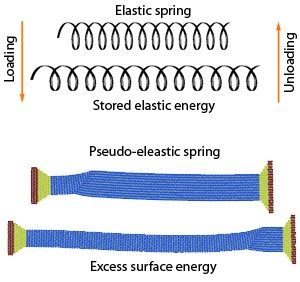|

14 June 2010
from
NatureAsia Website
Calculations show that a metallic nanowire can store energy
efficiently in the arrangement of its surface atoms.
Devices ranging from wrist watches to
toys can all be powered by elastic springs.
In a similar manner, nanoscale springs
can store energy when bonds between atoms are stretched in response
to an external mechanical force. When the spring relaxes, the bond
lengths return to normal and so the stored energy is released.
However, although ubiquitous, elastic
springs are also limited in particular ways:
they can withstand only so much
strain, and can store only a relatively small amount of energy
in a given volume.
Now, a team of Chinese and US scientists
led by Xiangdong Ding at Xi’an Jiaotong University,
Ju Li at the University of Pennsylvania and En Ma
at Johns Hopkins University have proposed storing energy in a
nanoscale spring not by changing its atomic bond lengths, but by
reconfiguring its surface atoms1 (Fig. 1).

Fig. 1
Whereas a standard
elastic spring stores energy in its atomic bonds (top),
the proposed nanowire
spring (bottom) stores energy in the arrangement of its surface
atoms,
in a phenomenon
called ‘pseudo-elasticity’.
Their calculations predict that this
would result in a 16,000-fold increase in energy volume density
compared with a watch spring.
The researchers demonstrated this ‘pseudo-elastic’ behavior in a
thin metallic nanowire. Applying a stretching force induces a defect
that travels down the length of the nanowire. This in turn causes
the atoms at the nanowire surface to assume a higher energy
arrangement, thus storing the initial energy applied to the nanowire.
Ding and his colleagues found that if
the nanowire is made of tungsten and has a particular atomic
configuration, the motion of the defect will encounter very low
friction, allowing 98% of the stored energy to be recovered when the
nanowire relaxes.
Further calculations indicate that the
nanowire can withstand a strain of 30% and a stress of over 3 GPa.
This performance compares well with existing energy storage
materials such as:
-
piezoelectrics, which can
withstand only small strains
-
electroactive polymers, which
can withstand only low stresses and have low energy
densities
-
shape memory alloys, which are
inefficient at releasing stored energy
Furthermore, the small scale of the
nanowires presents interesting opportunities; they can, for example,
be combined into dense arrays, allowing them to store a greater
total energy.
In addition to introducing a new material for storing mechanical
energy, the results contribute to the understanding of this
important physical phenomenon for many potential applications, says
Ding.
“Surface-energy-driven
transformations involving the ordered cooperative movements of
many atoms may result in other novel functional properties of
nanoscale materials, including information storage.”
Reference
1. Li, S.,1 Ding, X.,1* Li, J.,1,2
Ren, X.,1,3,4 Sun, J.1 & Ma, E.1 High-efficiency mechanical
energy storage and retrieval using interfaces in nanowires. Nano
Lett. 10, 1774 (2010) -
article
Author affiliation
1. State Key Laboratory for
Mechanical Behavior of Materials, Xi’an Jiaotong University,
Xi’an 710049, China
2. Department of Materials Science and Engineering,
University of Pennsylvania, Philadelphia, Pennsylvania
19104, USA
3. Ferroic Physics Group, National Institute for Materials
Science, Tsukuba, 305-0047 Ibaraki, Japan
4. Department of Materials Science and Engineering, Johns
Hopkins University, Baltimore, Maryland 21218, USA
* Email:
dingxd@mail.xjtu.edu.cn
|

